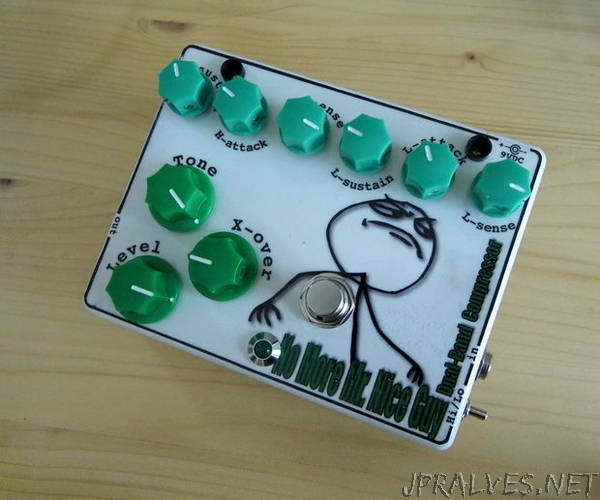
“Background story:
My bass playing friend was getting married and I wanted to build him something original. I knew he has a bunch of guitar/bass effect pedals, but I never saw him use a compressor, so I asked. He’s a bit of a feature-addict so he told me the only compressors worth using are multi-band, lots of knobs to play around with. I had no idea what a multi band compressor was, so I googled around and found some example schematics (like here and here). Knowing that my friend would not be happy with a meager 5 button pedal, I decided to design my own dual-band (well, not ‘multi’ but ok…) compressor.
Bonus challenge:
No integrated circuits allowed - only discrete components and transistors. Why? Many compressors are based around integrated circuits such as multipliers or transconductance amplifiers. While these ICs aren’t impossible to obtain, they still form a barrier. I wanted to avoid this and also sharpen my skills at the art of discrete circuit design.
In this Instructable, I’ll share the circuit I came up with and were and how to tweak the design to your own liking. Most parts of the circuit are not particularly original. However, I advice against building this pedal from A to Z without doing some breadboarding/testing/listening of your own. The experience you gain will be well worth the time invested.
What does a (dual-band) compressor do?
A compressor limits the dynamical range of a signal (see the scope picture). An input signal having both very loud and soft parts will be transformed in an output being overall less changing in volume. Think of it as an automatic volume control. The compressor does so, by making a short-term estimate of the ‘size’ of the guitar signal, and then adjusting the amplification or attenuation accordingly. This is different from a distortion/clipper in the sense that a distortion works instantaneously on a signal. A compressor, while in the strict sense not a linear circuit, doesn’t (or shouldn’t) add much distortion.
A dual-band compressor splits the input signal in two frequency bands (high and low), compresses both bands separately and then sums the results. Obviously this allows for much more control, at the expense of a more complicated circuit.
Soundwise, a compressor makes your guitar signal more ‘tight’. This can go from quite subtle, making it easier to mix the signal in with the rest of the band while recording, to very outspoken, giving the guitar a ‘Country’ feel.
Some good further reading on compressors is given here and here.”
